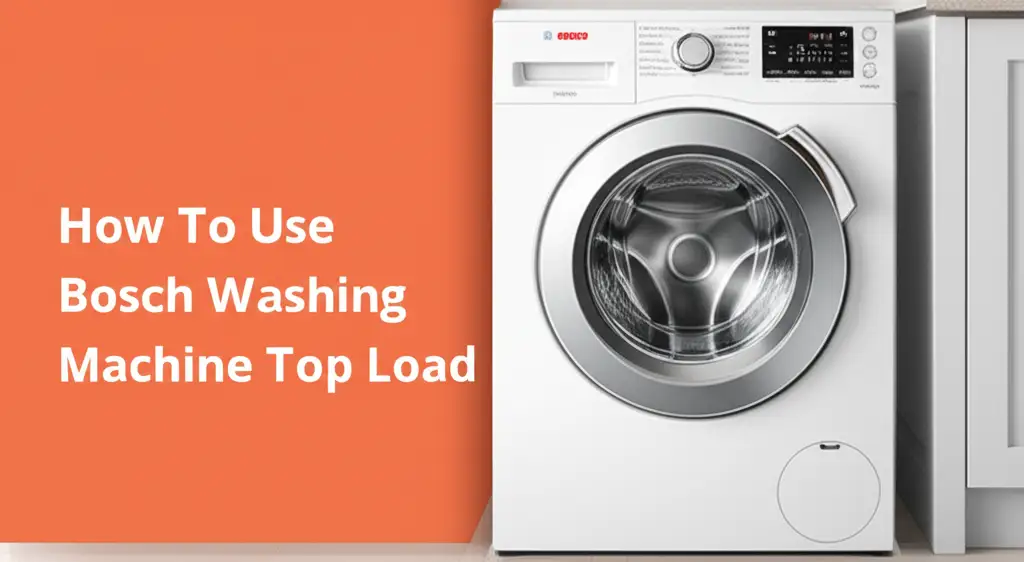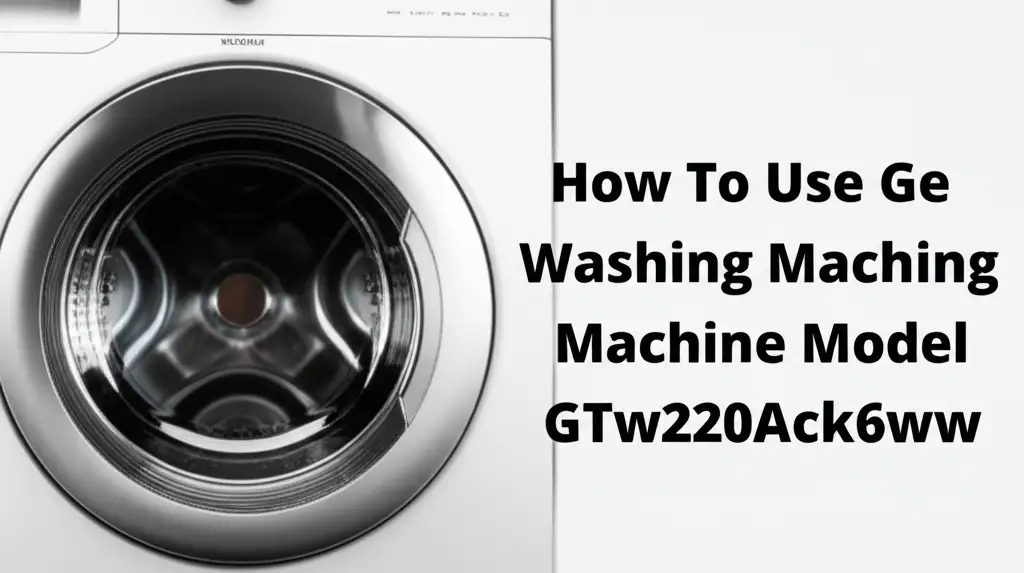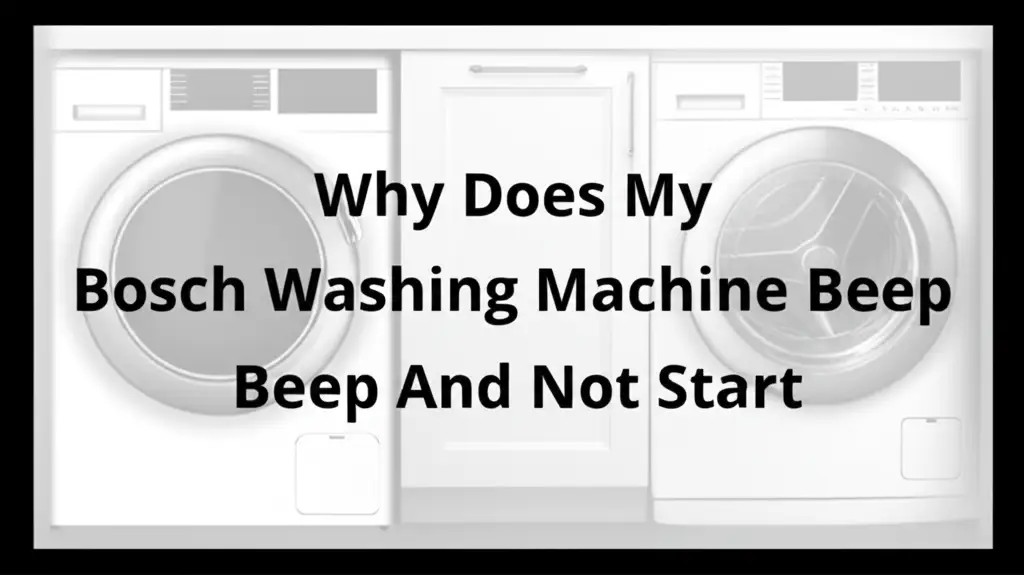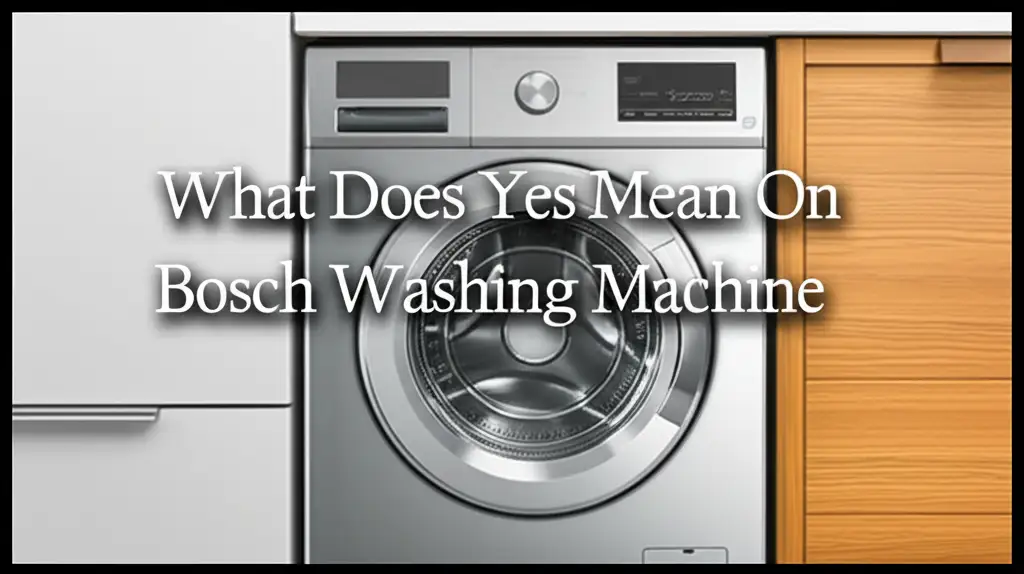· Todd Martin · Home Appliances · 18 min read
How To Use Bosch Washing Machine Top Load

How to Use Your Bosch Top Load Washing Machine
Getting a new appliance always brings a mix of excitement and questions. You are ready to tackle laundry day with your new Bosch top load washing machine. But how do you get the best results? Understanding its features and settings ensures your clothes come out perfectly clean every time. I often find that mastering my appliances makes daily chores much easier. This guide helps you learn how to use Bosch washing machine top load models effectively. We will cover everything from basic setup to advanced features and maintenance tips.
Takeaway
- Proper Installation: Ensure your Bosch top load washer is level and connected correctly to water and power.
- Cycle Selection: Choose the right wash cycle based on fabric type and soil level for optimal cleaning.
- Detergent Use: Add the correct amount and type of detergent to the designated dispenser.
- Loading Technique: Distribute laundry evenly to maintain balance and prevent machine strain.
- Regular Maintenance: Clean your washer regularly to prevent odor and maintain efficiency.
Clear, Concise Answer
To use a Bosch top load washing machine, first load your sorted laundry evenly into the tub. Then, add the correct amount of detergent and any additives to their specific dispensers. Next, select the appropriate wash cycle and desired settings like water temperature. Finally, close the lid and press the start button to begin the wash.
Getting Started with Your Bosch Top Load Washing Machine
Setting up your new Bosch top load washing machine correctly is the first step toward efficient laundry. Proper installation ensures safe operation and the best performance from your appliance. I always double-check these initial steps to avoid problems later. This foundation helps you understand how to use Bosch washing machine top load models with confidence.
Unpacking and Placement
When your Bosch top load washer arrives, carefully unpack it. Remove all packing materials, including shipping bolts or straps. These materials protect the machine during transit but must be removed before use. Failing to remove them can cause serious damage during operation.
Next, choose a suitable location for your washer. This area should have a level floor, access to hot and cold water faucets, a drain, and a grounded electrical outlet. A stable surface prevents excessive vibration and noise during cycles. I make sure my washer sits perfectly level.
Connecting Water and Power
Connect the hot and cold water inlet hoses to their corresponding faucets on the wall and to the designated inlets on the back of your washer. Ensure these connections are tight to prevent leaks. You should use new hoses if the old ones show any signs of wear. After connecting, turn on the water supply fully.
Position the drain hose correctly into a standpipe or laundry tub. It must be secured to prevent it from coming out during the drain cycle. Finally, plug the power cord into a grounded electrical outlet. Always avoid using extension cords, as they can be a fire hazard.
Initial Setup and Calibration
Many Bosch top load washing machines have an initial calibration cycle. This cycle helps the machine sense and adjust to the load size. It ensures optimal water usage and spin performance. Consult your user manual for specific instructions on running this calibration cycle.
Running a small, empty load with detergent can also help clean out any manufacturing residues. This primes the machine for its first real laundry load. I usually run this empty cycle to make sure everything is clean inside.
Understanding Bosch Top Load Wash Cycles
Knowing your Bosch top load washing machine’s wash cycles is key to successful laundry. Each cycle is designed for specific fabric types and soil levels. Selecting the correct cycle protects your clothes and gets them cleaner. I always check the care labels on my garments first.
Common Wash Cycles and Their Uses
Bosch top load washers typically offer a range of wash cycles. Each cycle combines different temperatures, agitation levels, and spin speeds. Understanding these combinations helps you make the right choice.
- Normal/Cotton: This is your everyday cycle for sturdy fabrics like cottons, linens, and mixed loads. It uses moderate agitation and spin. It handles average soil levels well.
- Delicates/Hand Wash: This cycle is for fragile items such as silk, lace, or lingerie. It uses very low agitation and a gentle spin speed. This prevents stretching and damage to delicate materials.
- Heavy Duty: Use this cycle for heavily soiled items like work clothes, towels, or jeans. It uses higher agitation and longer wash times. This helps to remove stubborn dirt and stains.
- Quick Wash/Speed Perfect: Ideal for lightly soiled items or when you need clothes fast. This cycle completes a wash in a shorter time. It uses less water and energy but may not be suitable for large or very dirty loads.
- Bulky Items/Bedding: This cycle is for large items that absorb a lot of water, like comforters, blankets, or pillows. It uses specific fill levels and agitation to ensure these items get thoroughly cleaned.
- Permanent Press: This cycle helps reduce wrinkles in synthetic fabrics. It uses warm water, a cool rinse, and a slower spin speed. This minimizes creasing, making ironing easier.
Special Cycle Options
Beyond the basic cycles, Bosch top load washing machines often include special options. These options allow for further customization. They help you achieve specific laundry results.
- Pre-Soak: This option adds an initial soak phase before the main wash. It is great for very dirty items or those with dried-on stains. The soak helps loosen dirt, making the main wash more effective.
- Extra Rinse: Adding an extra rinse ensures all detergent is removed from your clothes. This is beneficial for people with sensitive skin or allergies. It also helps with bulky items that might retain more suds.
- Spin Speed: You can often adjust the spin speed. Higher spin speeds remove more water, reducing drying time. Lower speeds are better for delicate items to prevent damage.
- Temperature Selection: You can choose between hot, warm, and cold water. Hot water is best for whites and heavily soiled items. Warm water suits most fabrics and colors. Cold water saves energy and protects dark colors from fading.
Choosing the right cycle and options makes a big difference in how your clothes look and last. I always consider the fabric type and how dirty the items are before I start a cycle.
Detergent and Additives for Bosch Top Loaders
Using the correct detergent and additives is vital for getting your clothes clean. It also protects your Bosch top load washing machine. Incorrect use can lead to sudsing problems, residue on clothes, or even machine damage. I pay close attention to this step.
Choosing the Right Detergent
Bosch washing machines are designed for high-efficiency (HE) detergents. HE detergents produce fewer suds. This is important for front-load and modern top-load washers, which use less water. Regular detergents create too many suds, which can overflow the machine or leave residue on clothes. Too many suds also make the machine work harder, reducing its lifespan.
You can use various forms of HE detergent in your Bosch top load washer:
- Liquid HE Detergent: This is the most common choice. It dissolves easily and distributes well.
- Powder HE Detergent: Some people prefer powder detergent. Ensure it is explicitly marked as “HE” for best results. You can learn more about using powder detergent by reading our guide on can you use powder detergent in Bosch washing machine.
- Detergent Pods/Packs: These are convenient pre-measured packets. They dissolve quickly in water. Most pods are designed for HE machines. For more details, you can refer to our article about can you use pods in Bosch washing machine.
Always read the detergent manufacturer’s instructions for the correct dosage. Overdosing can lead to excessive suds and residue. Underdosing might not clean your clothes properly.
Adding Detergent and Additives
Bosch top load washing machines have specific compartments for detergent and other additives. Familiarize yourself with these compartments before adding anything.
- Main Wash Detergent Compartment: This is where you put your liquid or powder HE detergent for the main wash cycle. Do not overfill this compartment.
- Fabric Softener Compartment: This section holds liquid fabric softener. The machine dispenses it automatically during the rinse cycle. Avoid pouring fabric softener directly onto clothes, as it can stain them.
- Bleach Compartment: If your machine has one, this is for liquid chlorine bleach. The machine dilutes and dispenses it at the appropriate time during the wash cycle. Never mix bleach directly with detergent.
Always add detergents and additives before starting the wash cycle. If you are hand-adding during the cycle (which is generally not recommended for Bosch top loaders), wait for the water to fill and disperse the product. However, using the dispenser is always the best method. I make sure to clean the dispenser regularly to prevent buildup. This keeps it working correctly.
Loading Your Bosch Top Load Washing Machine Correctly
Properly loading your Bosch top load washing machine is crucial for effective cleaning. It also extends the life of your appliance. An unbalanced load can cause excessive vibrations, noise, and even damage to the washer. I always take a moment to load carefully.
Sorting Laundry
Before loading, sort your laundry by color, fabric type, and soil level. This prevents colors from bleeding and ensures each load gets the appropriate wash cycle. For example, wash delicates separately from sturdy items. Heavily soiled items should not be mixed with lightly soiled ones. Sorting ensures a better cleaning outcome for all your clothes.
Load Size and Balance
Achieving the right load size is essential. Overloading prevents clothes from moving freely, leading to poor cleaning results. It can also strain the motor and other components. Underloading, on the other hand, wastes water and energy. Aim for a load that fills the tub loosely. Clothes should have enough room to tumble and circulate during the wash.
When loading, distribute items evenly around the agitator or wash plate. Avoid putting all large items on one side. This can create an unbalanced load. For instance, if you are washing a few large towels, spread them out instead of piling them up. An unbalanced load can cause the machine to shake violently during the spin cycle. This can trigger an error code or even stop the cycle. Some machines have sensors that detect imbalances and try to redistribute the load. However, it is best to prevent it from happening in the first place.
Preventing Damage to the Washer
Certain items should not be washed in a top load machine, or they require special care.
- Small, Loose Items: Small items like socks or baby clothes can get caught in the agitator or between the tub and the outer casing. Use a mesh laundry bag for these items.
- Heavy, Water-Absorbent Items: Large, heavy items like bath mats or comforters can become very heavy when wet. They can also create an unbalanced load. If washing such items, ensure they are distributed evenly. Consider washing one large item at a time or pairing it with lighter items for balance.
- Items with Zippers or Hooks: Close all zippers, hooks, and fasteners before washing. This prevents them from snagging other clothes or scratching the inside of the washer tub. Turn garments with zippers inside out.
- Foreign Objects: Always check pockets for coins, keys, or other small objects. These items can damage the washer’s pump or drum. I once found a pen in my pocket after a wash; it could have caused issues.
- Over-Foaming: As discussed, using non-HE detergent or too much detergent causes excessive suds. This can overflow the machine and damage internal components. Always use HE detergent and follow dosage recommendations.
By following these loading guidelines, you help your Bosch top load washing machine work efficiently. You also protect your clothes from damage.
Selecting the Right Settings on Your Bosch Washer
Beyond choosing the wash cycle, your Bosch top load washing machine offers various settings. Adjusting these settings helps you customize each wash for optimal results. Understanding them ensures your clothes receive the care they need. I find that tailoring these settings makes a big difference.
Water Temperature Options
Water temperature is a crucial setting that impacts cleaning power and fabric care. Bosch washers offer several temperature choices:
- Hot Water: Best for white cottons, heavily soiled items, and items needing sanitization, like baby clothes or towels. Hot water effectively dissolves detergents and helps remove stubborn stains. However, it can fade colors and shrink certain fabrics.
- Warm Water: A good all-around choice for most fabrics and colors. Warm water provides a balance between cleaning power and fabric protection. It is effective for moderately soiled items and helps prevent fading.
- Cold Water: Ideal for dark colors, delicates, and lightly soiled items. Cold water saves energy and helps prevent shrinking and fading. Modern HE detergents are formulated to work well in cold water. I use cold water for most of my daily laundry to save energy.
Always check the care label on your garments. This label provides specific temperature recommendations to prevent damage.
Spin Speed Adjustment
The spin speed setting determines how much water is extracted from your clothes during the final spin cycle. Higher spin speeds remove more water, which reduces drying time. However, higher speeds can also cause more wrinkles and be harsh on delicate fabrics.
- High Spin: Suitable for sturdy fabrics like towels, denim, and cotton. It helps to dry clothes faster.
- Medium Spin: A balanced option for everyday mixed loads.
- Low Spin: Recommended for delicate items, permanent press clothes, and fabrics prone to wrinkling. It minimizes creasing and wear.
- No Spin/Drain Only: This option drains the water without spinning. It is useful if you want to hand-wring delicate items or if you need to drain the tub without disturbing clothes. If you ever need to get your Bosch washing machine to spin only, you can learn how by visiting our guide on [how to get Bosch washing machine to spin only](https://homeessentialsguide.com/how-to-get-bosch-washing-machine-to spin only). A related resource for specific spin-only instructions is found at how to spin only in Bosch washing machine.
Extra Rinse and Pre-Soak
Many Bosch top load washers offer additional options to enhance cleaning or rinsing:
- Extra Rinse: This adds an additional rinse cycle after the main wash. It is beneficial for people with sensitive skin or allergies. It ensures all detergent residue is thoroughly rinsed away. I often use this for my towels to make sure they are super clean.
- Pre-Soak: This option allows clothes to soak in water with or without detergent before the main wash cycle begins. It is highly effective for heavily soiled items or tough stains. The pre-soak helps loosen dirt and allows the detergent to penetrate better.
By customizing these settings, you can optimize your Bosch top load washing machine’s performance. This results in cleaner clothes and extends their lifespan.
Troubleshooting Common Issues with Bosch Top Load Washers
Even the best appliances can encounter occasional issues. Knowing how to troubleshoot common problems with your Bosch top load washing machine can save you time and money. Many minor issues have simple solutions. I always try these basic checks first.
Washer Not Starting or No Power
If your Bosch washer does not start, check these basic points:
- Power Supply: Ensure the power cord is fully plugged into a working electrical outlet. Test the outlet with another appliance to confirm it has power. Check if a circuit breaker has tripped or a fuse has blown.
- Lid Closed: Top load washers have a lid switch that prevents operation if the lid is open. Make sure the lid is completely closed and latched.
- Water Supply: Check if the hot and cold water faucets are fully open. The machine needs water to start most cycles.
- Error Codes: Your washer’s display might show an error code. Consult your user manual for the meaning of specific codes. These codes can guide you to the exact problem. If your Bosch washing machine is not working, our article on why my Bosch washing machine is not working provides a helpful resource for diagnosis.
Washer Not Draining or Spinning
Problems with draining or spinning often relate to clogs or unbalanced loads:
- Drain Hose: Check if the drain hose is kinked or clogged. Ensure it is properly inserted into the standpipe or laundry tub.
- Pump Filter: Over time, lint, coins, or small items can clog the pump filter. A clogged filter prevents the machine from draining properly. Locate and clean the pump filter according to your user manual. This is a common maintenance item. Our article on how to clean Bosch washing machine pump filter offers detailed steps.
- Unbalanced Load: An unevenly distributed load can prevent the machine from spinning. The washer’s sensors detect this imbalance and stop the spin cycle to prevent damage. Open the lid, redistribute the clothes evenly, and try the spin cycle again.
- Excess Suds: Too much detergent can create excessive suds, which can interfere with the spin cycle. The machine might add extra rinse cycles to eliminate the suds, prolonging the wash time.
Excessive Noise or Vibration
Some noise is normal during washing machine operation, but excessive noise or vibration indicates a problem:
- Leveling: Ensure the washer is perfectly level. Adjust the leveling feet at the bottom of the machine. An unlevel machine will rock and vibrate.
- Load Balance: As mentioned, an unbalanced load can cause significant vibration, especially during the spin cycle. Redistribute the items.
- Shipping Bolts: If the machine is new and vibrating excessively, double-check that all shipping bolts were removed from the back of the washer.
- Foreign Objects: Items like coins or small toys can get caught in the drum or pump, causing rattling noises. Check the drum and pump filter for foreign objects.
If your Bosch washing machine keeps beeping, this often signals a specific issue. You can find more information on common beeping reasons in our guide on why does my Bosch washing machine keep beeping. Always refer to your Bosch user manual for specific troubleshooting steps and error code explanations. Contact Bosch customer service if you cannot resolve the issue.
Maintaining Your Bosch Top Load Washing Machine
Regular maintenance is essential for the longevity and efficiency of your Bosch top load washing machine. Proper care prevents odors, ensures optimal cleaning performance, and avoids costly repairs. I make sure to follow a consistent maintenance schedule for all my appliances.
Cleaning the Tub and Agitator
Over time, detergent residue, fabric softener, and hard water minerals can build up inside the washer tub. This buildup can lead to unpleasant odors and leave residue on your clothes.
- Self-Clean Cycle: Many Bosch top load washers have a “Tub Clean” or “Self Clean” cycle. Run this cycle monthly. It uses hot water and high agitation to clean the inside of the tub. Follow your manual’s specific instructions.
- Cleaning Agents: You can use a dedicated washing machine cleaner or simple household ingredients. Our guide on how to use Bosch washing machine cleaning powder provides detailed instructions on using specialized products.
- Vinegar Method: Add two cups of white vinegar to the detergent dispenser or directly into the tub. Run a hot, empty wash cycle.
- Baking Soda Method: After the vinegar cycle, or in a separate cycle, add half a cup of baking soda to the detergent dispenser. Run another hot, empty wash cycle. This helps to neutralize odors.
- Wipe Down: After each use, leave the lid slightly ajar to allow the interior to air dry. This prevents mold and mildew growth. Wipe down the drum, agitator, and lid gasket with a damp cloth.
Cleaning Dispensers and Filters
Detergent and fabric softener dispensers can accumulate residue, becoming clogged. This affects how well your products dispense.
- Detergent Dispenser: Remove the detergent dispenser tray if possible and wash it under warm water. Use a small brush to scrub away any residue. If it is not removable, wipe it thoroughly with a damp cloth.
- Lint Filter (if applicable): Some top load washers have a lint filter, often located near the top of the agitator or just inside the tub opening. Check your manual to see if your model has one and how to clean it. Remove any accumulated lint after every few washes.
- Pump Filter: As mentioned in troubleshooting, the pump filter prevents debris from reaching the pump. It needs regular cleaning, typically every few months, depending on usage. Cleaning this filter prevents drainage issues.
External Care and General Tips
- Wipe Exterior: Regularly wipe down the exterior of your Bosch washer with a soft, damp cloth. Use mild soap if needed. Avoid abrasive cleaners that can damage the finish.
- Leveling Check: Periodically check that your washer remains level. Adjust the leveling feet as necessary to prevent vibrations and noise.
- Hose Inspection: Inspect water inlet hoses every few years for cracks, bulges, or leaks. Replace them if they show signs of wear to prevent potential flooding.
- Unplug When Not In Use: If you plan to be away for an extended period, it is wise to unplug the washer and turn off the water supply.
By dedicating a little time to maintenance, you ensure your Bosch top load washing machine continues to perform its best. Regular cleaning keeps your clothes fresh and your appliance running smoothly for years.
Advanced Tips for Bosch Top Load Washer Users
Beyond basic operation, there are advanced tips that can enhance your Bosch top load washing machine experience. These insights help you maximize efficiency and tackle specific laundry challenges. I enjoy finding new ways to get the most out of my appliances.
Optimizing Detergent and Water Usage
Modern Bosch top load washers are designed for water and energy efficiency. You can further optimize this by smart detergent and water management.
- Pre-treating Stains: Address stains before washing. Pre-treating allows you to use less detergent in the main wash cycle. This also prevents stains from setting. Apply a stain remover directly to the spot.
- Water Hardness: If you have hard water, you might need to adjust your detergent dosage. Hard water minerals can reduce detergent effectiveness. Some users add a water softener to their wash to improve cleaning in hard water areas.
- Load Size and Cycle Match: Always match your load size to the chosen cycle. Using a “Heavy Duty” cycle for a small, lightly soiled load wastes water and energy. Use the “Quick Wash” for smaller, less dirty loads.





